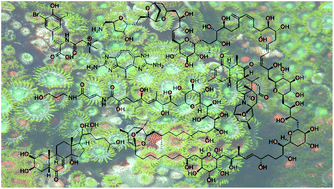Marine natural products from zoantharians: bioactivity, biosynthesis, systematics, and ecological roles
Abstract
Covering: up to the end of 2018
Zoantharians, also improperly known as zoanthids or colonial anemones, are well known by aquarists because of their ease of use in aquaria but also because of their splendid colours. However, high concentrations of the highly toxic palytoxin found in some species of zoantharians maintained in reef aquaria has raised some issues recently, unveiling at the same time a rather unknown chemical diversity hidden in these marine beauties. Herein, we report the structure of the metabolites described in all species of zoantharians up to the end of 2018 and their associated biological activities. As sessile invertebrates, zoantharians harbour a rich diversity of micro-organisms that can play a role in the biosynthesis of these natural products and we detail the current hypotheses on the metabolic pathways leading to the identified ecdysteroids, zoanthoxanthins, zoanthamines, palytoxins and others. Finally, we assess the possible use of these metabolites in the systematics of such a complex group of marine invertebrates and we discuss their possible ecological roles. Altogether, this review brings some insights into the rich chemical diversity of zoantharians and their potential for marine biodiscovery and marine ecology.



 Please wait while we load your content...
Please wait while we load your content...